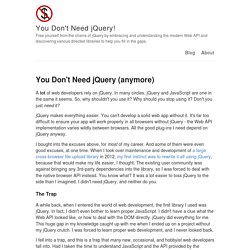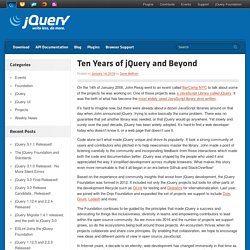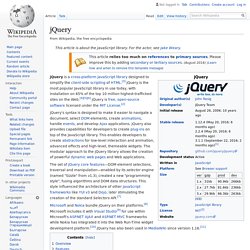

You Don't Need jQuery (anymore) – You Don't Need jQuery! – Free yourself from the chains of jQuery by embracing and understanding the modern Web API and discovering various directed libraries to help you fill in the gaps. A lot of web developers rely on jQuery.

In many circles, jQuery and JavaScript are one in the same it seems. So, why shouldn't you use it? Why should you stop using it? Don't you just need it? jQuery makes everything easier. I bought into the excuses above, for most of my career. The Trap A while back, when I entered the world of web development, the first library I used was jQuery. I fell into a trap, and this is a trap that many new, occasional, and hobbyist web developers fall into.
Learn JavaScriptLearn the Web APILearn jQuery (or any other framework/library that you may need across projects) Many start with #3, and #1 & #2 come much later (or never). Cross-Browser Support One of the most touted reasons for pulling in jQuery is to fix the "broken DOM API". The Web API as a whole is, more or less, quite advanced and capable since IE8. JavaScript Another common reason to pull in jQuery is to make up for perceived shortcomings in the underlying language itself (JavaScript). Coming Up Next. jQuery considered harmful. Heh, I always wanted to do one of those “X considered harmful” posts*.

Before I start, let me say that I think jQuery has helped tremendously to move the Web forward. It gave developers power to do things that were previously unthinkable, and pushed the browser manufacturers to implement these things natively (without jQuery we probably wouldn’t have document.querySelectorAll now). And jQuery is still needed for those that cannot depend on the goodies we have today and have to support relics of the past like IE8 or worse.
However, as much as I feel for these poor souls, they are the minority. There are tons of developers that don’t need to support old browsers with a tiny market share. Yes, you probably don’t really need it… I’m certainly not the first one to point out how much of jQuery usage is about things you can do natively, so I won’t spend time repeating what others have written. I will also not spend time talking about file size or how much faster native methods are. Ten Years of jQuery and Beyond. On the 14th of January 2006, John Resig went to an event called BarCamp NYC to talk about some of the projects he was working on.

One of those projects was a JavaScript Library called jQuery. It was the birth of what has become the most widely used JavaScript library ever written. It’s hard to imagine now, but there were already about a dozen JavaScript libraries around on that day when John announced jQuery, trying to solve basically the same problem. There was no guarantee that yet another library was needed, or that jQuery would go anywhere. Yet slowly and surely over the past decade, jQuery has been widely adopted. Code alone isn’t what made jQuery unique and drove its popularity. Based on the experience and community insights that arose from jQuery development, the jQuery Foundation was formed in 2012.
In Internet years, a decade is an eternity; web development has changed immensely in that time as has the web itself. jQuery - Wikipedia. This article is about the JavaScript library.

For the actor, see Jake Weary. jQuery is a cross-platform JavaScript library designed to simplify the client-side scripting of HTML.[3] jQuery is the most popular JavaScript library in use today, with installation on 65% of the top 10 million highest-trafficked sites on the Web.[4][5][6] jQuery is free, open-source software licensed under the MIT License.[2] The set of jQuery core features—DOM element selections, traversal and manipulation—enabled by its selector engine (named "Sizzle" from v1.3), created a new "programming style", fusing algorithms and DOM data structures.
This style influenced the architecture of other JavaScript frameworks like YUI v3 and Dojo, later stimulating the creation of the standard Selectors API.[7] Overview[edit] jQuery, at its core, is a DOM (Document Object Model) manipulation library. jQuery also provides a paradigm for event handling that goes beyond basic DOM element selection and manipulation. Features[edit]